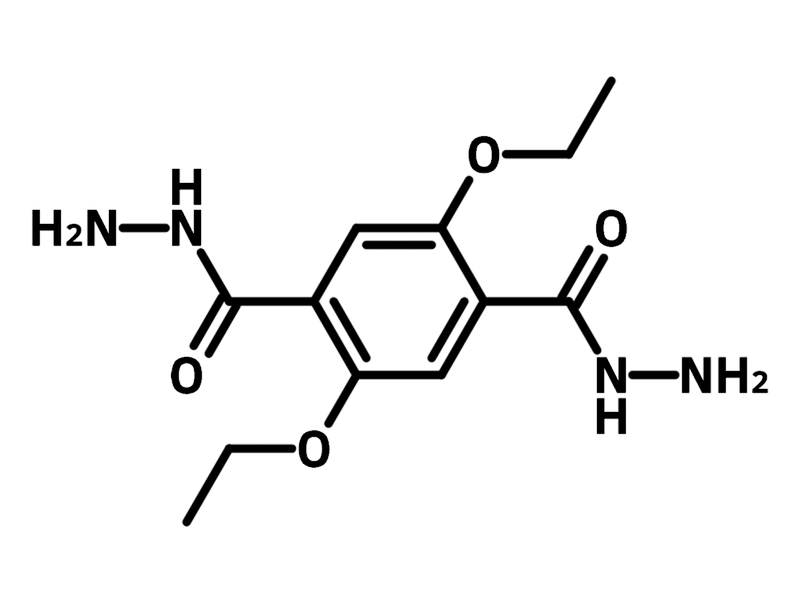2,5-Diethoxyterephthalohydrazide
CAS Number 1136292-71-1
Chemistry Building Blocks, COF Ligands, Materials, Porous Organic FrameworksCovalent organic frameworks (COFs) terephthalohydrazide ligand
serves as a linker for COFs enabling applications including photocatalytic hydrogen evolution, CO2 sorption, sensors and filtration membranes
Specifications | MSDS | Literature and Reviews
2,5-Diethoxyterephthalohydrazide (CAS number 1136292-71-1), is a para-diethoxybenzene substituted with two carbohydrazide at 1-, 4-potition. 2,5-Diethoxyterephthalohydrazide is well-known for its synthesis of COF-42 with 1,3,5-triformylbenzene. COF-42 is chemically robust due to its hydrazide linkers and is widely employed as the platform for photocatalytic hydrogen evolution. When 2,5-diethoxyterephthalohydrazide reacts with metalated-porphyrinic aldehydes, it produces 2D COFs (MPor-DETH-COFs, M: Zn, Ni, Co). These MPhor-DETH-COFs exhibit photocurrent of up to 0.9 μA/cm2 and an average hydrogen evolution rate up to 413 μmol/g/h.
COFs synthesized from 2,5-diethoxyterephthalohydrazide and triformylbenzene derivatives feature large amount of amines in the network making it favorable for capturing CO2. These COFs show a high surface area of 2336 m2/g and CO2 uptake capacities ranging from 1.14-2.66 mmol/g.
Facile reactions
Hydrazide possesses excellent reactivity
High Purity
>98% Purity
Worldwide shipping
Quick and reliable shipping
MOF and COF ligands
hydrazide ligand for cross-linked COF networks
General Information
| CAS Number | 1136292-71-1 |
| Chemical Formula | C12H18N4O4 |
| Full Name | 2,5-Diethoxyterephthalohydrazide |
| Molecular Weight | 282.30 g/mol |
| Synonyms | 2,5-diethoxybenzene-1,4-dicarbohydrazide, DETH |
| Classification / Family | Terephthalohydrazides, Hydrazide ligands, COFs ligands, MOF ligands, Hydrogen evolution, CO2 sorption |
Chemical Structure

Product Details
| Purity | 98% |
| Melting Point | N/A |
| Appearance | White powder |
MSDS Documentation
2,5-Diethoxyterephthalohydrazide MSDS Sheet
Literature and Reviews
- Rational design of covalent cobaloxime-covalent organic framework hybrids for enhanced photocatalytic hydrogen evolution, K. Gottschling et al., J. Am. Chem. Soc., 142, 12146–12156 (2020); DOI: 10.1021/jacs.0c02155.
- Molecular insights into carbon dioxide sorption in hydrazone-based covalent organic frameworks with tertiary amine moieties, K. Gottschling et al., Chem. Mater. ,31, 1946–1955 (2019); DOI: 10.1021/acs.chemmater.8b04643.
- Light-emitting covalent organic frameworks: fluorescence improving via pinpoint surgery and selective switch-on sensing of anions, Z. Li et al., J. Am. Chem. Soc., 140 (39), 12374–12377 (2018); DOI: 10.1021/jacs.8b08380.
